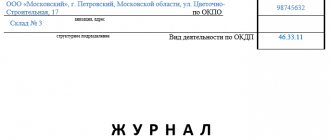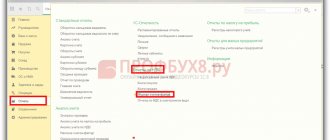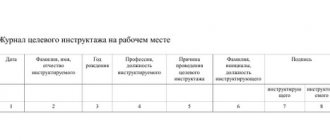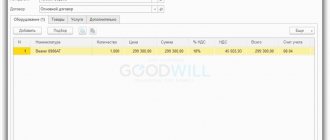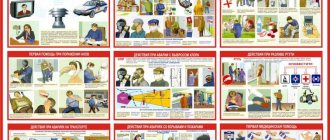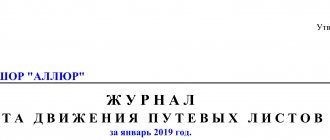Why do you need a fire safety training log in the workplace?
Mastering the theoretical part of safety precautions at an enterprise is a prerequisite for admitting a newly arrived employee to his workplace. In addition to introductory training, other types of classes are provided for employees, depending on their length of service at the enterprise or other special conditions. There are a total of 5 types of training for staff:
- introductory;
- primary;
- repeated;
- target;
- planned.
It is unacceptable to treat filling out the instruction registration book as a mere formality. Indeed, in the event of an emergency at the enterprise, it will confirm that training sessions were conducted with employees. And any inspection by the fire department will first require a log.
The manager or person responsible for safety is responsible for the timeliness and correctness of filling out the log. The authorized employee must have perfect knowledge of the discipline being taught and have experience working at the enterprise in question. In addition, he is required to have personal qualities that will help ensure a safe environment in the enterprise.
Important! Often, upon arrival to a new position, an employee undergoes simultaneously training in fire safety and labor protection. In such a situation, appropriate entries in separate journals are necessary.
Special magazines
In addition to the mandatory documents appearing in the field of labor protection, there are some special papers. Let's look at the most common of them.
Read more: How to write a letter about the allocation of funds
Accounting for the issuance of certificates
According to the Resolution of the Ministry of Labor of Russia, the Ministry of Education of Russia No. 1/29, management staff and specialists are obliged to undergo a special training program that covers the obligations for each employee.
Activities begin immediately after employment and must be completed during the first working month. The development of programs is carried out on the basis of industry, nature of work, and working conditions. The complete list is approved by the management team.
For personal convenience, employees working in the HR department often use a journal to record the issuance of occupational safety certificates. It is used to record information about all certificates that have been issued. The document is maintained by a responsible competent specialist.
Within the framework of Art. 197 of the Labor Code of the Russian Federation states that every employee has the right to free professional training. The apprenticeship agreement is drawn up under conditions that do not imply the separation of the employee from the production process.
- the number of certificates that were issued;
- control of their provision, tear-off coupons;
- features relating to electrical workers;
- data on copies issued to management;
- information on permits to work in hazardous conditions.
Although the document does not belong to the list of mandatory documents, its use is recommended.
Regarding labor protection orders
Another special document is the log of orders related to labor protection. It helps to systematize all information and improve the work process in terms of increasing the level of security. It is recommended to obtain this document at your site, workshop or department.
It must contain a certain number of instructions, orders regarding internships, permission to work independently, and assignment of responsible persons. It is maintained in a single copy in accordance with the general procedure.
Fire safety induction log form
To ensure that the responsible employee does not have problems with the inspection authorities, it is important to learn how to fill out the logbook for the introductory fire safety briefing.
Traditionally, each page of such a book contains a table with columns:
- Date of instruction;
- Full name of the employee who attended the instruction;
- year of birth of the person being instructed;
- listener's position;
- type of instruction;
- Full name of the instructor;
- signatures of participants.
For unscheduled briefings, an indication of the reason that forced the organization of the event is required.
Immediately after the training, the employee who conducted the instruction, as well as the persons who listened to it, are required to sign the log. This confirms that the lesson has taken place.
Under no circumstances should trainee information be filled out in advance, as not all expected staff may show up for the training. Registration must be made after the fact, immediately after the lesson.
Logbook for fire safety briefings: sample filling
The fire safety briefing log is a mandatory document that reflects information about the training or testing of personnel knowledge in the field of fire safety. It is an A4 book, on the cover of which the name of the enterprise and its division is indicated, and on the main pages there is information about the training provided.
For clarity, below is a page from the fire safety briefing magazine, sample 2021:
Before you start filling out the log, it is important to make sure that it meets the following requirements:
- Convenient firmware. The sheets must be stitched with thin lace or thread. It is important to make sure that all pages open comfortably and that the text is completely readable.
- Seal. After stitching the book, the ends of the lace are glued to the cover along with a special sticker. It indicates the number of sheets in the magazine, the lacing date and information about the responsible employee. After the glue has dried, a stamp is placed on the sticker and part of the cover.
- Numbering. Page counting can start from the cover or from the first page with a table. For numbering, a pen, a stamp, or a printout can be used. The main thing is that the page numbers are indicated before using the book.
It is not necessary to buy a ready-made printed book; you can make your own fire safety briefing log. The form to fill out can be taken online and printed in the required quantity.
Recommendations for preparing accounting and registration logs:
Numbering of sheets.
All journal sheets are numbered in the upper right corner, starting from the second. The numbering of sheets in files is necessary to secure the order in which documents are arranged after stitching (lacing) to ensure their safety. It is necessary to number all sheets in the file, except for the inventory. If the document file contains an envelope with enclosed sheets, then number the envelope first, then each enclosed sheet in turn. Blank sheets of paper are removed from the case (without damaging the integrity of the case) and destroyed. The sheets are numbered in pencil from top to bottom in ascending order of numbers, starting from the first. The numbers are placed in the upper right corner of the sheet, without affecting the text of the documents. The internal inventory sheets are numbered separately.
Firmware of documents
The numbered sheets are stitched with strong thread using two or three punctures. In the left margin (half of the free margin, in order to preserve the readability of the document texts when flipping through the file) of a multi-page document, holes are made with a needle or an awl, or all pages are punched with a hole punch at the same level. It is best to stitch documents using a piercing needle with bank twine or LS stitching threads -210. If you don’t have such a thread, you can use a strong (nylon or regular, folded several times) thread. Documents are usually stitched twice - for reliability. The ends of the thread are tied in a knot and brought to the back of the last numbered sheet. You need to leave about 5 - 6 cm of free end.
The case should be sealed with a paper sticker with an inscription.
The sticker with the certification inscription can have dimensions of approximately 4 by 5 - 6 cm. Glue the sheet so that it covers the knot and part of the length of the threads. The ends of the threads must be free. The certification is signed after the glue has dried. example: In this magazine, 50 (fifty) sheets are numbered, laced and sealed. It is signed by the head of the organization or a person authorized by him. The manager's signature must be clear and legible. The seal must be located both on the sticker with the certification inscription and on the sheet. The seal impression, located both on the sticker and on the document sheet, as well as the knot and threads filled with glue, serve to indicate the integrity of the document.
Read more: Main goals of privatization of municipal property
List of documents
To record documents of certain categories of permanent and temporary (over 10 years) storage, the recording of which is caused by the specifics of this documentation (especially valuable, personal files, files with restricted access documents, etc.), an internal inventory of case documents is compiled. The inventory is not numbered and must contain the following data: name of the document, date of compilation of the inventory, title (possibly with an annotation - for what purposes the set of documents is intended), a listing of all filed documents indicating the number of sheets, surname, position and signature of the inventory compiler.
- After the last registration entry (when the journal has ended), the employee responsible for office work makes an entry (without quotes), for example: 128 documents from N 1 to N 129 are registered in this journal. Number 33 is omitted. Then the position is indicated, the official’s signature is affixed and its decoding;
- All registration logs at the end of the year are handed over to the archives with other documents, and from the beginning of the new calendar year new logs are started.
These recommendations are of a general nature. When preparing personnel documentation, the employer should take into account special rules for the preparation of journals and books, the maintenance of which is classified as mandatory by law.
The fire safety briefing logbook has an official form, which is established by Order of the Ministry of Emergency Situations of Russia dated December 12, 2007 N 645.
Only the person responsible for fire safety can instruct workers about the rules of behavior in the event of a fire and compliance with fire safety measures to prevent it. The responsibility for it is primarily the head of the organization, who himself is obliged to study and provide training in the fire safety technical minimum for workers responsible for industrial safety.
The manager appoints responsible persons by order. If necessary, each department assigns a separate employee to this role who has undergone off-the-job training and the necessary knowledge testing.
Rules for filling out the logbook for fire safety briefings
The legislation establishes strict standards for filling out and maintaining current logs, as well as storing archival documents.
When filling out the pages of the journal, it is prohibited:
- skip, fill in lines in the journal with dashes or the letter “Z”;
- cross out, paste over, cut out, erase mistakes;
- tear out sheets and insert new pages in their place;
- make notes with a pencil or marker.
Important! When filling out the journal, skipping individual columns is not allowed: all cells are filled in in order.
If an error is made in the entry, then to correct it you must carefully cross out the entire line (preferably under the ruler). Under the crossed out line, make a note “erroneous entry”, where the responsible person puts his signature and date. The correct information is written in the following blank lines.
A situation is possible in which an error is not detected immediately, but after a while, when new data has been entered after an incorrect entry. In this case, the algorithm of actions is similar. The only difference is that the correct information is filled in on the next blank line.
It is not allowed to make entries about fire safety instructions in a journal intended for labor protection.
Keeping a log of training on fire safety measures
Taking into account the size and type of activity of the enterprise, it is allowed to create separate copies of the magazine for different divisions: department, team or shift. In addition, it is allowed to keep one journal for recording the introductory briefing on fire safety, and one for all subsequent ones.
At enterprises with separate divisions, the responsibility for conducting briefings may be assigned to the heads of these divisions.
In addition to correctly filling out the journal, it is important to ensure its proper use and storage. This is possible subject to the following conditions:
- Additional sheets cannot be pasted;
- it is important to limit the access of unauthorized persons to the journal;
- pages and title page must be protected from moisture or mechanical damage (folders or covers are used for this);
- the color of the filling paste should not exceed the requirements for document management.
After filling out the last line, the end date of the journal is indicated on the title page. After which the document is sent to the archive for storage for a period of 10 years.
The training program is aimed at preventing fires caused by staff illiteracy. During training, employees learn the rules for using equipment, storage conditions for various types of materials, hazard factors at the enterprise, first actions in case of fire, and escape routes. Therefore, a fire safety briefing log is not just a formality, but a reliable way to ensure the fire safety of a facility.
Safety Briefings: Introductory Notes
Before we begin to consider the issue of design and numbering of the registration journal
instruction on labor protection, it is necessary to make a few introductory remarks about the essence and procedure for carrying out this event.
In its most general form, safety training is a training session that can take a variety of forms. The purpose of these classes is always the same - to teach future or current employees safe working methods, provide information about the rules of conduct in the workplace, and also practice procedures in the event of injury or an emergency. Russian labor legislation regulates the procedure for conducting classes and the requirements for them.
On a note
- Employees who refuse to undergo safety training cannot be allowed to work by their employer.
- There is no uniform regulation for conducting training. Each area of work may have its own characteristics of conducting occupational safety classes. They are stipulated by special industry regulations.
Safety instructions
A typical safety lesson, which is conducted for all employees of the organization, as well as specialists from other companies hired to work in this organization, consists of studying the basics of safe work, based on three types of documents:
Read more: How to calculate utilities for tenants
local regulations of the company;
technical documentation for equipment operation;
general instructions on occupational health and safety.
Despite the fact that the procedure for conducting classes may vary from company to company, there are Sample training plans developed by the Ministry of Labor of the Russian Federation, which are recommended to be taken into account when preparing an employee training plan.
In turn, the safety instructions themselves, which are the main subject of these classes, must also be developed by the employer himself. This provision is enshrined in Art. 212 Labor Code of the Russian Federation. Traditionally, this responsibility rests with an occupational safety specialist. However, in the course of drawing up instructions, he has the right to seek advice from specialists from specialized services, in particular the medical unit.
It should be especially noted the need to consult with representatives of the trade union body, if one operates in the organization. This is determined by Art. 372 Labor Code of the Russian Federation.

